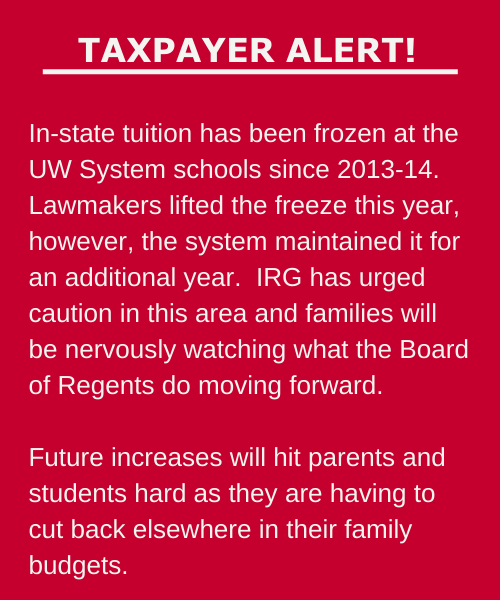Click here for a printable version of our report or read the full version below.
State Agency Fast Facts:
The UW System oversees 13 four-year campuses and 13 two-year campuses, this is in addition to the 16 two-year technical colleges in the Wisconsin Technical College System.
The University of Wisconsin System’s current biennial budget of $12.9 billion has increased by more than $750 million since 2017. The majority of the System’s funding comes from students, who bring state, federal, and scholarship aid.
Statewide, the system employs 35,671 employees, which is 332 more than in 2017 – to serve 162,980 students. If it were a city, these faculty and staff would make it the 26th biggest in Wisconsin, similar in size to Manitowoc and West Bend.

Did you know?
While most states have both public four-year universities and two-year colleges, Wisconsin is unique in that it has both the Wisconsin Technical College System and the UW System’s two-year schools.
Nationwide, over 40% of all associate degrees were in liberal arts, general studies, and humanities. More than 80% of these associate degree students said they planned to complete a 4-year degree too. However, after 6 years, only 9% of community college students had done so. Graduates of 2-year general studies programs earn far less than their peers who earn other types of 2-year degrees.
Wisconsin, along with other states must consider the value of its degrees and whether it is wise to continue to push two-year degrees in the liberal arts.
Reform History:
Major reforms of the UW System have been rare since it was first created in 1971. Since then, it has grown by leaps and bounds, both in terms of budget and physical footprint. A plan by Governor Walker to spin UW-Madison out of the system would have given it more autonomy to grow and innovate while placing less burden on state taxpayers. That plan did not move forward due to opposition by other campuses and many of their elected representatives.
UW System, led by its flagship campus in Madison, has long been a leader in innovation, research, and has frequently ranked at the top of lists of the best programs nationwide in a variety of academic disciplines. While many of these schools are still well-regarded, some rankings have slipped. For example, UW-Madison ranked 3rd in research and development expenditures nationwide as recently as 2012, but now has dropped to 8th. Other universities have innovated by better embracing the development of basic research into real-world applications. Other universities such as Purdue and Arizona State have actually acquired other universities to help them fill offerings they lack and better serve students.

Close Call…
In Governor Evers’ 2021-23 budget, he proposed giving the University of Wisconsin new authority to borrow without legislative approval at a time when it is receiving record levels of federal stimulus funds and facing record levels of uncertainty. This authority would have given UW a no-limit credit card if it had been approved by the legislature.
Keep and Eye on:
As with K-12 schools, the nation’s colleges and universities have seen recent windfalls from Covid-related stimulus and, just recently, forgiveness of hundreds of billions in student debt. These one-time funds must be spent soon and, if they are not spent wisely, the system and its campuses will face shortfalls at a time when enrollment is shrinking with the future uncertain.
IRG Wants to Know:
If you were in charge for a day, what reforms would you make to the UW? Email Alex Ignatowski, IRG’s Director of State Budget and Government Reform, at [email protected].

